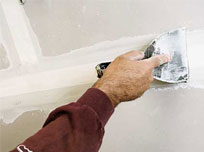Fixing Nail Pops is a common occurrence in a house with children.This article is an excerpt form book called “STANLEY COMPLETE DRY WALL” by “Des Moines“.
Nail pops are an annoyance that can ruin the appearance of an otherwise smooth wall. Fortunately they are quite easy to fix. Pity the unfortunate homeowner who finds dozens of them throughout the house on both walls and ceilings.
The usual reason for a nail pop is framing lumber with a moisture content that is too high. During installation, the nail has a good grip on the wood. But as the lumber dries, it shrinks away from the drywall, which has the effect of pulling the nail out of the wood. Any pressure on the drywall panel—which now is no longer in contact with the framing—pushes the nail head against the compound concealing it, creating a mound.
The situation will be even worse if the original drywall hanger hung the panel loosely. For best results, you should always press the panel firmly against the framing with one hand while driving the fastener with the other.
A strong light glancing across the surface will help you quickly see nail pops. You’ll also probably discover that the original installer drove the nails in a regular pattern. Screws can also pop, although much less frequently. Please see the fastener selection guide on page77.
PRESTART CHECKLIST
- TIME – Driving the nail and applying the first coat of compound may take 10 seconds or less per pop
- TOOLS – Drywall hammer, mud pan with drywall knife
- SKILLS – Driving nails, applying compound
- PREP – Move furniture away from walls and remove pictures and other accessories
- MATERIALS – Drywall nails, all-purpose compound
Process
1. Dig the joint compound out of one mounded area; you’ll find the head of a fastener (usually a nail). Position a new ring shank nail next to the head of the old fastener and drive it with a drywall hammer. The rounded head of the hammer will smash the mound into a dimple.
2. To fix other nail pops, position the new nail slightly off the center point of the mound and drive it to capture the head of the popped fastener. When you nail, push the drywall firmly against the stud or joist.
WHAT IF… You need to fix a crack along an outside corner?
A hairline crack parallel to an outside corner is usually caused by a too-think application; of compound. The stresses of uneven drying produce a crack. The fix involves enlarging the crack with a utility knife and applying a fresh coat of joint compound. For better insurance against a repeat of the crack, dig out even more compound and span the repair with joint tape.
STANLEY PRO TIP
To tape or not to tape?
Fixing dents and gashes in drywall is a common job. A common question is whether or not the repair requires a layer of joint tape. Here’s an easy rule of; thumb: If the face paper is intact, you can skip the tape. But if the paper is cut or ripped, you’ll need to reinforce the area with tape. Paper tape, which is thinner than fiberglass mesh, is usually easier to conceal.
Prep a gashed area by using a utility knife to neatly trim away any snagged face paper, so it won’t get in the way of your repair.
Continue reading about Repairing Holes

